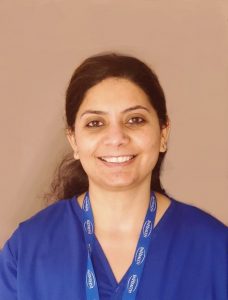Isha Yadav
Clinical Lead Radiographer
The London Upright MRI Centre
Who or what inspired you to pursue a career as a Radiographer?
My sister is a doctor and I was greatly inspired by her so I decided to follow her footsteps, unfortunately I could not clear the entrance exam but still fascinated with healthcare went for an all-India exam for paramedical and chose radiography as my profession.
How did you qualify as a Radiographer?
My close friend suggested radiography field and together we secured a place in one of the top institute PGIMER Chandigarh in India. It was a bachelors degree, three years course in Radio Diagnosis and Imaging (BSc. In Medical Technology) followed by internship in a government college.
What does your role involve?
I am a clinical Lead radiographer at London Upright MRI Centre, I manage the clinical side of operations and also scan patients.
Describe a typical working day in the Upright MRI Centre.
A typical day involves scanning 10 to 12 patents which seems easier as compared to other tunnel scanners, but at Upright open scanner our patients are severely claustrophobic and some have failed to have scans in lying down scanner, so they need more empathy and care.
We are able to successfully scan claustrophobic and very large patients as we have an extraordinary patient–friendly environment, where the patient faces out and can watch a large flat-screen TV with an unobstructed view. The patient simply walks in, sits down, and watches TV and they are not slid into the usual tube.
We can scan patients in any position, including sitting, standing, bending (for flexion and extension) or lying down.
In current times we need to ensure that we are keeping ourselves and our patients safe, which is our upmost priority so we are taking extra time and effort in cleaning scanner and MRI environment in between patients.
We keep ourselves up to date with all new policies and procedure to learn and maintain good service for our patients.
What are the values that drive you?
I believe good communication is key for building trust with patients and providing a good service. I always like to know what my patients feel and fear when they are sat in our scanner. By explaining them the procedure clearly and thoroughly they feel at ease and complete their scan.
My positive attitude is my strength I can make quick decisions at the time of need and maintain good rapport with my fellow colleagues.
What is the most challenging part of your role?
As our scanner is an Upright rather than a routine lying down scanner it can be challenging to achieve scans on patients with restricted mobility and weight and but with 13 years of experience, we get through most of these difficult cases with best images which was a real struggle in earlier years.
What is the most rewarding part of your job?
The most rewarding part of my job is that we are helping people to get a diagnosis.
When I see a sense of relief on my patients face after they complete their scan it gives me a feeling of achievement and keeps me motivated to help and care.
What is your secret talent (that nobody knows) or something that has made you smile recently?
I love dancing and, in this lockdown, when my 5-year-old daughter is having her lessons on zoom I am secretly improvising my Bollywood moves with her.


